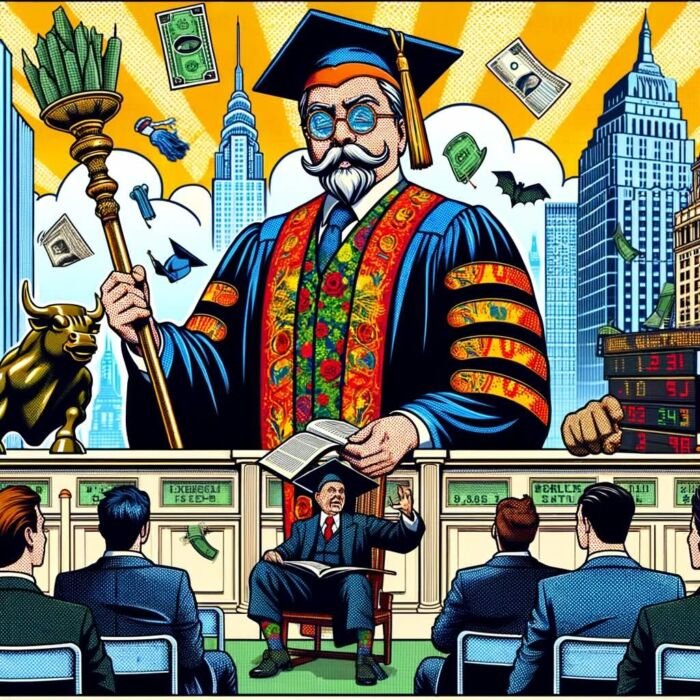Nestled at the apex of the global financial ecosystem, amidst the swirling frenzy of Wall Street sharks and Silicon Valley trailblazers, stands a paragon of investment wisdom – Warren Edward Buffett. His name reverberates with authority and reverence, a symbol of the mythical ability to spin the mundane strands of market data into solid gold returns.

The esteemed “Oracle of Omaha”, as he is widely known, has carved out an illustrious path in the world of finance, morphing from an eager young student of economics to a titan of investment. His sage-like financial insights and patient, long-term approach have not only earned him a stellar reputation but have also fundamentally altered the trajectory of investment philosophy itself. His influence spans beyond mere individuals, permeating the curriculum of business schools, shaping corporate strategies, and swaying market sentiments.

Yet, the shimmering legend of Warren Buffett is not one of overnight success or sudden fortune. Rather, it is a narrative rooted in the simplicity of middle America, woven from threads of innate curiosity, unflinching persistence, and an early, deep-seated love for numbers. As with any profound journey, it is necessary to start at the beginning to truly understand its magnitude.
In this deep-dive, we peel back the layers of Warren Buffett’s early years, tracing his path from a boyhood in Omaha to his formative academic years under the mentorship of Benjamin Graham at Columbia Business School. We chart the pivotal moments and experiences that culminated in the creation of the investment behemoth that is Berkshire Hathaway. This exploration is not merely biographical, but also a quest to uncover the lessons, inspirations, and key factors that contributed to Buffett’s almost prophetic knack for discerning the financial future.

So, prepare yourself for a journey back in time, a voyage to the very inception of an Oracle. Step into the realm of Warren Buffett’s formative years, a period of exploration and growth that fashioned an ordinary Nebraska boy into an extraordinary financial luminary. This story is not just a chronicle of wealth accumulation, but a testament to the power of knowledge, integrity, and tenacity. This is a tale that delves into the construction of an enduring investment philosophy, a testament of resilience, and a narrative about the birth of a legacy that continues to inspire and guide millions.

Early Life: Warren Buffett’s Upbringing in Omaha, Nebraska
Born on August 30, 1930, in the heart of America’s breadbasket, Warren Edward Buffett was the second of three children and the only son to Leila and Howard Buffett. Raised in a middle-class family in Omaha, Nebraska, Buffett’s formative years were steeped in the simplicity and practicality typical of mid-western America. Yet, even in these earliest chapters of his life, a singular passion emerged – an insatiable curiosity for numbers and an inherent fascination for business.
Buffett’s childhood was a blend of modest circumstances and ambitious dreams. While his father ran a small stock brokerage, his mother managed household affairs, their home a steady backdrop to the symphony of life in the heartland of America. However, it was within these homespun surroundings that Buffett’s earliest entrepreneurial seeds were sown. Under the vast Nebraska skies, the boy who would become the Oracle of Omaha began to craft his destiny.

Influence of Parents and Early Indications of Business Acumen
Warren Buffett’s parents had an indelible impact on his life, shaping not just his character but also his world view. His father, Howard Buffett, was a businessman and a four-term Republican U.S. congressman, who instilled in young Warren the principles of integrity, hard work, and financial prudence. On the other hand, his mother, Leila Stahl Buffett, was a disciplined and somewhat stern figure, teaching Warren valuable lessons in resilience and determination.
While most children of his age were engrossed in play, Warren showed an early inclination towards numbers and business. His first foray into the world of commerce came at the tender age of six when he purchased six-packs of Coca-Cola from his grandfather’s grocery store, only to sell them for a neat profit. Whether it was delivering newspapers, selling golf balls, or stamp collecting, young Buffett seemed to have an uncanny knack for identifying opportunities to make money.
However, these ventures were more than just child’s play for Buffett; they were early testing grounds for his investment principles. For instance, his paper route not only earned him money but also gave him an understanding of recurring income. His stamp collecting hobby, on the other hand, taught him about the concept of rarity and value. These early life experiences, infused with lessons learned from his parents, gradually moulded the mind of one of the greatest investors the world has ever seen.
Thus, the Oracle of Omaha’s tale doesn’t begin in bustling stock exchanges or towering corporate offices, but in the humble streets of Omaha, Nebraska. It is here, under the watchful eyes of Howard and Leila Buffett, that Warren Buffett began honing his unique financial acumen, setting the stage for a lifetime of extraordinary achievements.
source: The Swedish Investor on YouTube

Warren Buffet’s Education
From Omaha’s Central High School to the esteemed halls of the Wharton School at the University of Pennsylvania, Buffett’s academic journey was marked by an intense focus on finance and investment. His early fascination with numbers found a perfect arena in business school, where he eagerly absorbed the tenets of economics and financial management.
Buffett’s Academic Journey: Wharton Business School and Columbia Business School
After two years at Wharton, a restless young Buffett transferred to the University of Nebraska, where he would earn a Bachelor of Science degree in Business Administration. While Wharton offered him the prestige and rigor of an Ivy League institution, it was at Nebraska where Buffett found the space to delve deeper into his own thoughts and theories on investing, proving to his professors and peers alike that he was not just another business student, but a financial maverick in the making.
Yet, the true turning point of Buffett’s educational journey arrived with his enrolment at Columbia Business School. Initially rejected by Harvard Business School, Buffett discovered that his idol, Benjamin Graham – the father of value investing, taught at Columbia. This fortuitous turn of events led Buffett to Columbia, where he would be mentored by Graham and profoundly influenced by his investment philosophy.

The Benjamin Graham Influence and the Formation of Buffett’s Investment Philosophy
In the hallowed halls of Columbia Business School, Buffett found more than just an education; he found a mentor, a guide, and a philosophy that would shape his investing career – Benjamin Graham. Graham’s book, ‘The Intelligent Investor’, had already had a profound impact on Buffett, but learning directly from the master was a transformative experience.
Graham, often dubbed as the ‘Dean of Wall Street’, wasn’t merely a professor to Buffett but a beacon of wisdom. His principles of value investing, focusing on intrinsic value and safety margins, resonated with Buffett and began to shape his approach to investing. The concept of viewing stocks not as mere ticker symbols but as pieces of a business, and the idea of purchasing them when they traded for less than their intrinsic value, formed the bedrock of Buffett’s investment strategy.
During his tenure at Columbia, Buffett not only excelled academically, but he also deeply imbibed Graham’s teachings. These lessons would become the cornerstone of his investment philosophy and ultimately serve as the foundation of his future success.
Thus, Buffett’s education, punctuated by his time at Wharton, Nebraska, and finally Columbia, wasn’t just about acquiring degrees. It was a quest for knowledge, an exploration of ideas, and most importantly, the forging of a lifelong philosophy under the tutelage of Benjamin Graham. From a curious boy in Omaha to a refined investor, Buffett’s educational journey was as much a part of his making as his early business ventures.
source: Bloomberg Originals on YouTube

Early Career Of Warren Buffett
Upon graduation from Columbia, armed with an arsenal of Graham’s wisdom, Buffett was eager to dive into the investment world headfirst. However, his initial attempts to join his mentor’s firm, Graham-Newman Corporation, were met with a polite rebuff. This, however, did not deter the tenacious Nebraskan.
Buffett returned to Omaha and took up a job as a stockbroker while teaching an “Investment Principles” night class at the University of Nebraska-Omaha. All this while, he remained in touch with Graham, exchanging letters brimming with business ideas and stock analyses.
Buffett’s persistence eventually paid off when, in 1954, Graham offered him a job. Working alongside his mentor was an enriching experience for Buffett, who likened it to a devout Christian being given a chance to work with Saint Paul. The two years he spent at Graham-Newman Corporation allowed Buffett to apply the principles he had learned, further solidifying his confidence in the value investing approach.

Warren Buffett’s Return to Omaha and the Inception of Buffett Partnership Ltd.
However, in 1956, Graham decided to retire and wound up his partnership. This could have been a significant setback for most, but not for Warren Buffett. Instead, he saw it as an opportunity. Armed with the wisdom accumulated under Graham’s tutelage and his unique business acumen, Buffett returned to Omaha.
On May 1, 1956, with initial capital coming mostly from family and friends, he started Buffett Partnership Ltd. This venture marked a significant milestone in his career – it was Buffett taking the reins, charting his course, and putting his own stamp on the world of investment.
Buffett Partnership Ltd. operated by acquiring undervalued companies, a nod to Graham’s teachings, but Buffett also added his flair. He sought companies with strong management teams and potential for long-term growth. This mix of value and growth investing was a departure from Graham’s strict value principles, showing the world that while Buffett was a student of Graham, he was also an innovator in his own right.
The return to Omaha and the start of Buffett Partnership Ltd. signified not just the beginning of Buffett’s solo journey in investment but also a shift in his investment approach – one that would lay the foundation for his future empire, Berkshire Hathaway, and cement his status as one of the world’s greatest investors.
Formative Investments of Warren Buffet
In the vast canvas of Buffett’s investment career, the Sanborn Map Company holds a unique spot, representing one of his early, triumphal applications of value investing. Founded in 1866, Sanborn was a leading provider of detailed maps for insurance companies, a profitable venture in a less technologically advanced era.
Case Study: Sanborn Map Company and Buffett’s Value Investing Approach
By the 1950s, however, the company’s main business was dwindling due to advancements in technology and a shift in industry practices. Yet, an intriguing aspect caught Buffett’s keen eye: a significant investment portfolio that the company had built from its past profits.
The map business was valued at roughly $45 per share, yet Sanborn’s stock was trading for only $45 in the market. In essence, the market was giving no value to Sanborn’s hefty investment portfolio. This was the sort of discrepancy that Graham had taught Buffett to look for, and he seized the opportunity.
Buffett invested heavily in Sanborn, and by 1960, the Buffett Partnership owned 23% of Sanborn’s stock. He then used this leverage to effect changes in the company’s management and unlock the value of its investment portfolio. His actions led to a near doubling of the price per share, proving his investment a resounding success and validating his value investing approach.
Warren Buffett’s Investment in Berkshire Hathaway: The Shape of Things to Come
While Sanborn was an early victory for Buffett, another company would play a far more pivotal role in his career – Berkshire Hathaway. Originally a struggling textile mill, Berkshire Hathaway was just the sort of undervalued company that attracted Buffett.
In 1962, Buffett began buying Berkshire’s shares, attracted by its price lower than the company’s working capital. Despite the textile mill’s continuous struggle, Buffett continued buying shares, eventually taking control of the company in 1965. Yet, the textile business continued its downward trend, and by the 1980s, Buffett had to close the mill.
However, the initial investment had provided Buffett a holding company through which he could buy other businesses. Shifting away from the failing textile industry, Buffett started acquiring companies from various sectors, like insurance and media, transforming Berkshire Hathaway into a sprawling conglomerate.
The investment in Berkshire Hathaway marked a significant shift in Buffett’s career. It was more than just an application of value investing principles; it was the canvas on which Buffett would paint his masterpiece. Berkshire Hathaway would become the vessel through which Buffett would steer his course to becoming one of the most successful investors in history, leaving a legacy that continues to shape the world of finance.
source: Business Casual on YouTube
Building of Berkshire Hathaway
As the 1960s drew to a close, Buffett made a significant decision that would define the rest of his career: he chose to shift his primary investment vehicle from Buffett Partnership Ltd. to Berkshire Hathaway.
From Buffett Partnership Ltd. to Berkshire Hathaway: A Strategic Shift
This decision was far from impulsive. Buffett saw a broader and more flexible potential in Berkshire Hathaway, one that could allow him to venture beyond mere undervalued stocks and into the realm of entire businesses.
In 1969, he liquidated Buffett Partnership Ltd., and directed his own as well as his partners’ investments into Berkshire Hathaway. By merging his investment activities with Berkshire Hathaway, he transformed the struggling textile company into a dynamic investment powerhouse, establishing himself at the helm of what would soon be one of the most successful conglomerates in the world.
Strategy behind Key Early Acquisitions under Berkshire

Once the transition was complete, Buffett moved quickly to expand Berkshire’s portfolio. However, his strategy wasn’t about haphazard expansion; he sought out companies with enduring profitability, solid management, and businesses that were easy to understand. In essence, he looked for companies that represented value and were built to last.
One of the earliest and most successful acquisitions was the insurance company, National Indemnity. Insurance appealed to Buffett, as the ‘float’ (the premiums collected by an insurance company before claims are paid out) could be used for further investments.
He followed this up with other acquisitions, including a majority stake in GEICO, a company he had first encountered during his time with Benjamin Graham. The acquisition of See’s Candies for $25 million in 1972 demonstrated Buffett’s evolving investment strategy. While See’s was not the kind of bargain purchase Buffett traditionally sought, he recognized its strong brand value and customer loyalty, predicting its ability to generate cash flow.
Each acquisition was made with careful deliberation and a long-term perspective. The portfolio soon extended beyond insurance and encompassed a diverse range of businesses, from media with The Washington Post, to household goods with Fruit of the Loom.
The transformation of Berkshire Hathaway from a struggling textile firm to a powerful conglomerate was not an overnight phenomenon. It was the result of years of patient investing, strategic acquisitions, and the visionary leadership of Warren Buffett, all of which were set into motion during these pivotal early years. As the world watched, the Oracle of Omaha was gradually constructing his empire, reinforcing his position as a stalwart in the global financial arena.
source: Yahoo Finance on YouTube
Investment Philosophy of Warren Buffett
The Making of Buffett’s Value Investing Approach
At the core of Warren Buffett’s investment prowess lies his unwavering dedication to value investing. This approach, nurtured under the mentorship of Benjamin Graham, is about buying securities that appear underpriced by some form of fundamental analysis. It’s the art of buying a dollar for fifty cents, an art that Buffett mastered and refined over the decades.
Buffett’s approach was more than just seeking cheap stocks. He evolved Graham’s teachings by focusing on the quality of the business and its potential to generate cash flow over the long term. He looked beyond the balance sheet to the qualitative aspects of a business – factors like the brand’s strength, the business model’s sustainability, and the management’s capability.
The Benjamin Graham Influence
Benjamin Graham, often referred to as the father of value investing, was the single most significant influence on Buffett’s investment philosophy. The core tenets of Graham’s teachings, including the emphasis on intrinsic value, margin of safety, and the concept of Mr. Market, became the foundation of Buffett’s approach.
While Buffett embraced Graham’s concepts, he also evolved them. While Graham was primarily concerned with the numbers and didn’t care much about the nature of the business, Buffett took a keen interest in the business’s fundamental strength, sustainability, and its competitive advantage.

Understanding the “Buffett’s Principles”: Economic Moats, Intrinsic Value, and Management Integrity
- Economic Moats: Borrowing a term from medieval castles, Buffett referred to sustainable competitive advantages that protect a business from rivals as “economic moats. Whether it’s a powerful brand, network effects, or cost advantages, these moats, according to Buffett, are key to a company’s long-term profitability and success.
- Intrinsic Value: Buffett focuses on the “intrinsic value” of a company – what it’s truly worth based on its fundamentals, instead of its current market price. This principle emphasizes the importance of independent judgement and underscores the potential rewards of patience and long-term thinking.
- Management Integrity: Buffett places immense value on the quality of a company’s management. For him, integrity, intelligence, and energy are crucial management traits. He believes that a great business in the hands of a bad management team is likely to produce poor results.
Buffett’s investment philosophy is a blend of his learnings from Graham, his personal insights from years of investing, and an unwavering belief in the principles of value investing. His focus on economic moats, intrinsic value, and management integrity sets him apart and remains the guiding principles of his investment decisions, earning him a place among the greatest investors of all time.
source: The Plain Bagel on YouTube
Personal Life and Influence of Warren Buffett
Warren Buffett’s investment approach is not only shaped by his mentors and personal research but also deeply influenced by his personal life and beliefs.
The Impact of Buffett’s Personal Life on His Business Decisions
He is well-known for his frugality, a trait evident in both his personal life and investment style. Despite his extraordinary wealth, Buffett lives a modest lifestyle. He resides in the same Omaha house he bought in 1958 and is famously quoted as saying, “Price is what you pay, value is what you get” – a mantra he applies to both life and investments.
Buffett’s fascination with numbers and understanding the value of money began in his childhood. His early business ventures, such as selling chewing gum and Coca-Cola, and his various childhood jobs, taught him crucial lessons about commerce and hard work. His humble background and upbringing cultivated a strong sense of pragmatism and caution, which is reflected in his risk-averse approach to investing.

Warren Buffett as a Mentor and Philanthropist
Beyond his investment achievements, Buffett has also played an influential role as a mentor to many business leaders and investors, like Bill Gates, imparting the wisdom he acquired over the decades. His annual letters to Berkshire shareholders are revered as significant learning resources, filled with insights and wisdom about investing and business.
In the realm of philanthropy, Buffett has made his mark as one of the most generous philanthropists in the world. He has pledged to donate 99% of his wealth to philanthropic causes, primarily via the Gates Foundation. This monumental commitment reflects his belief in giving back to society, a principle that has greatly influenced his business decisions.
His ‘Giving Pledge’, a commitment by the world’s wealthiest individuals and families to donate the majority of their wealth to philanthropy, has encouraged many other billionaires to contribute towards societal improvement.
Buffett’s personal life and influence reach far beyond the confines of Wall Street. They manifest in his pragmatic and value-focused approach to investing, his dedication to mentoring future generations of business leaders, and his commitment to leveraging his wealth for the betterment of society. Thus, the making of the Oracle of Omaha is not just about the formation of an investment genius but also about the shaping of an influential mentor and philanthropist.

Lessons from Warren Buffett’s Early Years
Buffett’s early years offer a treasure trove of lessons for aspiring investors. His story emphasizes the importance of education and finding the right mentors, as his relationship with Benjamin Graham had a profound impact on his investment philosophy.
Teachings for Aspiring Investors
His investments in companies like Sanborn Map Company and Berkshire Hathaway illustrate the practical application of value investing principles. These cases highlight the importance of careful analysis, patience, and the courage to act decisively when an opportunity presents itself.
Moreover, Buffett’s frugality and focus on value over price underscore the need for a disciplined approach to investing. He demonstrated that success in investing doesn’t come from following the crowd but from independent analysis and a deep understanding of a company’s intrinsic value.

Warren Buffett’s Formative Years: Shaping Decisions and Approach Today
Even today, the teachings from Buffett’s early years continue to shape his decisions and investment approach. His unwavering commitment to value investing, despite market trends or popular opinion, has remained constant. The principles of seeking out undervalued companies, appreciating economic moats, and assessing management integrity continue to guide his investment choices.
Buffett’s early years taught him the importance of patience and long-term thinking, lessons that are clearly visible in his strategy today. Rather than chasing quick profits, he consistently advocates for a long-term investment horizon.
Finally, the experiences of his early life instilled in him a sense of humility and philanthropy. Despite his immense wealth, he has committed to giving the majority away to charitable causes. His humble lifestyle, in spite of his affluence, serves as a reminder of his grounded beginnings and the value-centric philosophy that he continues to uphold.
The lessons from Buffett’s early years are not merely historical footnotes but integral components of his ongoing investment philosophy and approach. They reflect the depth of his wisdom, the consistency of his strategies, and his unique perspective on wealth, making them as relevant today as they were when he first began his journey to becoming the Oracle of Omaha.
Conclusion: Early Years of Warren Buffett
Warren Buffett’s journey to becoming the “Oracle of Omaha” is a testament to the transformative power of early influences, diligent learning, and the steadfast application of a core set of principles.

Reflecting on the Oracle’s Genesis
His early years in Omaha, his education under Benjamin Graham, the ventures of his initial career, and the formative investments – each step was a building block in constructing his legacy. They served as both the crucible and the blueprint for the investment philosophy he would come to be renowned for.
His unerring focus on value, understanding of business fundamentals, and appreciation for strong management were fostered in these early years, setting the stage for his later accomplishments. Moreover, his personal life and the influence it exerted on his investment decisions underline the importance of a holistic approach to business, where personal values and societal commitments hold equal weight with profit margins.

Recalling the Oracle’s Path
In tracing Buffett’s early years, we journeyed through his humble beginnings in Omaha and examined the profound influence of his parents. We observed the foundations of his educational journey, enriched by the mentorship of Benjamin Graham. We followed him through the early years of his career, watching him apply and refine his investment strategy.
We also delved into key early investments, such as the Sanborn Map Company and Berkshire Hathaway, that shaped Buffett’s future. We learned about the transformation of Berkshire Hathaway, transitioning from a struggling textile company to a successful conglomerate under Buffett’s strategic acquisitions.
The exploration of Buffett’s investment philosophy provided insight into his unique approach to value investing, as well as the formative role played by Benjamin Graham. And finally, we noted the impact of Buffett’s personal life on his business decisions and his substantial influence through mentorship and philanthropy.
All these threads weave together to form the rich tapestry of Warren Buffett’s early years, reflecting how they shaped the exceptional investor, astute business leader, and generous philanthropist he is today. As we look back on the path that led to the Oracle of Omaha, we find not only a chronicle of financial success but also a wealth of lessons that continue to educate and inspire investors worldwide.
Important Information
Comprehensive Investment Disclaimer:
All content provided on this website (including but not limited to portfolio ideas, fund analyses, investment strategies, commentary on market conditions, and discussions regarding leverage) is strictly for educational, informational, and illustrative purposes only. The information does not constitute financial, investment, tax, accounting, or legal advice. Opinions, strategies, and ideas presented herein represent personal perspectives, are based on independent research and publicly available information, and do not necessarily reflect the views or official positions of any third-party organizations, institutions, or affiliates.
Investing in financial markets inherently carries substantial risks, including but not limited to market volatility, economic uncertainties, geopolitical developments, and liquidity risks. You must be fully aware that there is always the potential for partial or total loss of your principal investment. Additionally, the use of leverage or leveraged financial products significantly increases risk exposure by amplifying both potential gains and potential losses, and thus is not appropriate or advisable for all investors. Using leverage may result in losing more than your initial invested capital, incurring margin calls, experiencing substantial interest costs, or suffering severe financial distress.
Past performance indicators, including historical data, backtesting results, and hypothetical scenarios, should never be viewed as guarantees or reliable predictions of future performance. Any examples provided are purely hypothetical and intended only for illustration purposes. Performance benchmarks, such as market indexes mentioned on this site, are theoretical and are not directly investable. While diligent efforts are made to provide accurate and current information, “Picture Perfect Portfolios” does not warrant, represent, or guarantee the accuracy, completeness, or timeliness of any information provided. Errors, inaccuracies, or outdated information may exist.
Users of this website are strongly encouraged to independently verify all information, conduct comprehensive research and due diligence, and engage with qualified financial, investment, tax, or legal professionals before making any investment or financial decisions. The responsibility for making informed investment decisions rests entirely with the individual. “Picture Perfect Portfolios” explicitly disclaims all liability for any direct, indirect, incidental, special, consequential, or other losses or damages incurred, financial or otherwise, arising out of reliance upon, or use of, any content or information presented on this website.
By accessing, reading, and utilizing the content on this website, you expressly acknowledge, understand, accept, and agree to abide by these terms and conditions. Please consult the full and detailed disclaimer available elsewhere on this website for further clarification and additional important disclosures. Read the complete disclaimer here.






Honestly I have to disagree with some of this document, him buying and selling coca-cola at a young age is mostly likely because of his parents telling him so or his grandparents telling him so after all they were the ones who gave it to him. His grandparents wanted to teach him a lesson in business so they sold the coca cola to him and told him what to do. It’s also hard to confirm what his childhood details are correct or not. No matter what age you are it’s difficult to recall what happened 50 years ago and some of it can be filled with an unknown bias towards their child. Although in the latter years I can’t deny his genius but in his early years he was probably told what to do and he gets way to much credit now when he was young with what he did.